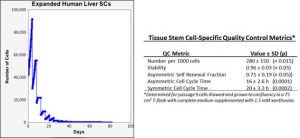First Report of Immortal DNA Strands in Human Stem Cells
Our partner Asymmetrex recently published a research report verifying the presence of immortal DNA strands in human tissue stem cells. The human liver stem cells used in the study were developed using Asymmetrex’s patented SACK tissue stem cell expansion technology, and they are available to researchers worldwide via the Kerafast catalog.
Before the new paper, published in the peer-reviewed journal Symmetry, prior publications had confirmed the presence of immortal DNA strands in stem cells in other species such as mold, plants, insects and mice. The new study describes the occurrence of immortal DNA strands in human stem cells for the first time.

Example of a tissue stem cell (left) holding on to its immortal DNA strands after dividing to produce a maturing tissue cell (right).
What is Immortal DNA?
When DNA replicates in a typical cell, the new cell components mix with older cell components while being divided between each new cell; essentially every cell is a new cell. Stem cells, however, are different. They have the potential to differentiate into many different cell types and are responsible for renewing mature body cells. Scientists had long hypothesized that they were immortal cells, yet no one could pinpoint a molecular concept for this idea.
In the 1970s, John Cairns, a pioneer of DNA replication, predicted that stem cells always retained one strand of all their chromosomes, never sharing those DNA strands with the tissue cells they renewed. Cairns named these immortal DNA strands, arguing that immortal DNA strands must exist to explain how immortal stem cells avoid higher cancer rates. By using the same DNA strands to replicate over a lifespan, the stem cells could avoid too many DNA duplication errors and therefore not turn cancerous.
Immortal DNA in SACK-X 12(3) Liver Stem Cells
The new paper describes the presence of immortal DNA strands in human liver stem cells called SACK-X 12(3) stem cells, available through Kerafast. They are the first and only commercial human tissue stem cell product supplied with their stem cell-specific dosage. Researchers can exponentially propagate a population of cells in vitro and induce differentiation when desired.
The SACK-X 12(3) human liver stem cells express the epithelial stem cell biomarker LGR-5 and the liver stem cell biomarker EpCAM. They display Xn-suppressed non-random sister chromatid segregation and have been quality controlled to determine the number of actual stem cells. The below figure shows an example of the stem cell quality control counting; click here for more information.
After the stem cells differentiate, the differentiated progeny cells display loss of LGR5 and EpCAM expression, as well as expression of the hepatocyte-specific nuclear receptor PXR. The cells secrete albumin, alpha-fetoprotein, and hepatocyte basement membrane proteins, as well as have inducible cytochrome P450 activity.
Next Steps
Now that normal human tissue stem cells have been shown to contain immortal DNA strands, researchers can use this knowledge to further our understanding of tissue stem cells for improving human health. If you work in this area of research, the SACK-Xs 12(3) neonatal human liver stem cells used in the study can be purchased online here. In addition, you might be interested in other stem cells developed using Asymmetrex’s SACK technology:
- SACK-Xn 3C5 Adult Mouse Hair Follicle Stem Cells (These mouse stem cells have also been shown to have SACK-dependent immortal DNA strands, in a Scientific Reports paper)
- SACK-Xs Lig-8 Clonal Adult Rat Hepatocytic Stem Cells
- SACK-Xs Lig-13 Clonal Adult Rat Cholangiocytic Stem Cells
Kerafast also offers additional stem cell products for research. For more information, contact us.



